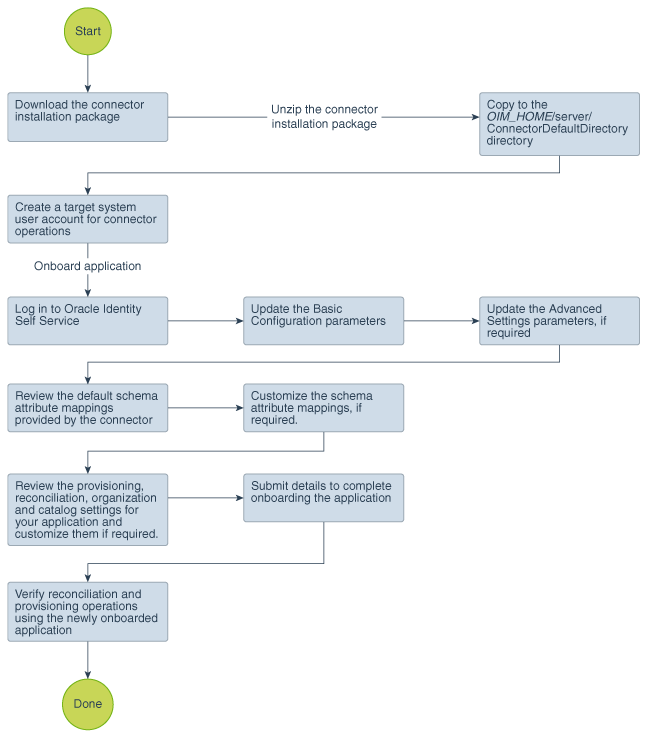2 Creating an Application by Using the Connector
Learn about onboarding applications using the connector and the prerequisites for doing so.
2.1 Process Flow for Creating an Application By Using the Connector
From Oracle Identity Governance release 12.2.1.3.0 onward, connector deployment is handled using the application onboarding capability of Identity Self Service.
Figure 2-1 is a flowchart depicting high-level steps for creating an application in Oracle Identity Governance by using the connector installation package.
Figure 2-1 Overall Flow of the Process for Creating an Application By Using the Connector

Description of "Figure 2-1 Overall Flow of the Process for Creating an Application By Using the Connector"
2.2 Prerequisites for Creating an Application By Using the Connector
Learn about the tasks that you must complete before you create the application.
2.2.1 Registering the Client Application
Registering a client application (that is, the Azure AD connector) with the target system is a step that is performed before creating an application instance so that the connector can access Azure AD Graph APIs. It also involves generating the client ID and client secret for authenticating to the target system and setting the permissions for the client application.
Preprovisioning involves performing the following tasks on the target system:
- Register your client application with Microsoft Azure Active Directory to provide secure sign in and authorization for your services. You can register your client application by creating an application in the Microsoft Azure Management Portal.
- Generate the client ID and client secret values for your client application. Note down these values as they are required while configuring IT resource parameters.
- Specify the permissions that the client application requires to access the target system. To do so:
2.3 Creating an Application By Using the Connector
You can onboard an application into Oracle Identity Governance from the connector package by creating a Target application. To do so, you must log in to Identity Self Service and then choose the Applications box on the Manage tab.
Note:
For detailed information on each of the steps in this procedure, see Creating Applications of Oracle Fusion Middleware Performing Self Service Tasks with Oracle Identity Governance.
- Create an application in Identity Self Service. The high-level steps are as follows:
- Verify reconciliation and provisioning operations on the newly created application.
See Also:
-
Configuring the Connector for details on basic configuration and advanced settings parameters, default user account attribute mappings, default correlation rules, and reconciliation jobs that are predefined for this connector
-
Configuring Oracle Identity Governance for details on creating a new form and associating it with your application, if you chose not to create the default form